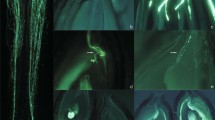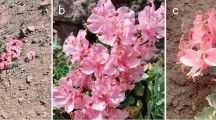Summary
-
1.
Some fruit was set by potato flowers which were pollinated at maturity stages from two days before they opened, to three days after the day on which they opened although the percentage of fruit set was highest for flowers pollinated the day on which they opened, or the day after they had opened. More seeds per fruit were developed from flowers pollinated just after they had opened than from those pollinated 24 hours before they had opened and these latter, in turn, produced more seeds per seedball than did those pollinated 48 hours before they opened.
-
2.
High temperature, measured in degree-hours above 70°F., for a period from 48 hours before the flower opened until 72 hours after it had opened, caused a greater reduction in fruit set than did high temperature on any one day. This heat effect seemed to be more closely associated with flower maturity than with time of pollination.
-
3.
Most pollen grains on stigmas of clones examined in this study seemed to germinate after the time that the flower would normally open regardless of the stage of maturity at which the flower was pollinated.
-
4.
The position of the flower within the cluster and the morning hour at which the flower was pollinated seemed to have little effect on the chances of that flowers setting fruit. The percentage of fruit set was as high for flowers pollinated in the evening as for those pollinated in the morning.
Similar content being viewed by others
Literature Cited
Buchholz, J. T. 1931. The dissection, staining, and mounting of styles in the study of pollen-tube distribution. Stain Tech. 6: 13–24.
Clarke, A. E. 1940. Fertilization and early embryo development in the potato. Amer. Potato Jour. 17:20–25.
— and P. M. Lombard. 1939. Relation of length of day to flower and seed production in potato varieties. Amer. Potato Jour. 16:236–244.
— and P. M. Lombard. 1942. Flower bud formation in the potato plant as influenced by variety, size of seed-piece, and light. Amer. Potato Jour. 19:97–105.
Driver, C. M. and J. G. Hawes. 1943. Photoperiodism in the potato. Imp. Bur. of Plant Breed, and Genetics. Dec. 1943: 36.
East, E. M. 1908. Techniques of hybridizing the potato. Amer. Soc. Hort. Sci. Proc. 5: 35–40.
Edmundson, W. C. 1942. Comparison of Katahdin potato pollen produced in the field and in the greenhouse. Amer. Potato Jour. 19: 12–15.
Federer, W. T. 1955. Experimental Design. The MacMillan Co., New York, 591 Pp.
Henderson, M. T. and F. L LeClerg. 1943. Studies on some factors affecting fruit setting inS. tuberosum in the field in Louisiana. Jour. Agr. Res. 66:67–76.
King, J. R. 1955. Pollen and pollination studies on Irish Potatoes. Amer. Potato Jour. 37: 7–14.
Longley, A. E. and C. F. Clark. 1930. Chromosome behavior and pollen production in the potato. Jour. Agr. Res. 41: 867–888.
Salaman, R. M. 1926. Potato varieties. Cambridge Univ. Pres, 378 Pp.
Werner, H. O. 1941. Effect on berry production of varied day length during the life of two Triumph potato strains. Amer. Potato Jour. 18: 174–178.
Young, W. J. 1923. The formation and degeneration of germ cells in the potato. Amer. Jour. Bot. 10:326–335.
Author information
Authors and Affiliations
Additional information
Part of a thesis submitted to the Graduate School of Cornell University in partial fulfillment of the requirements for the degree of Doctor of Philosophy.
Formerly Graduate Research Assistant, Department of Plant Breeding, Cornell University, and now Assistant Horticulturist, Idaho Agricultural Branch Experiment Station, Aberdeen, Idaho.
Rights and permissions
About this article
Cite this article
Bienz, D.R. The influence of environmental factors and pollinating techniques on the success of potato pollination in the greenhouse. American Potato Journal 35, 377–385 (1958). https://doi.org/10.1007/BF02851953
Accepted:
Issue Date:
DOI: https://doi.org/10.1007/BF02851953




